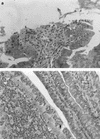Characterization of the roles of hemolysin and other toxins in enteropathy caused by alpha-hemolytic Escherichia coli linked to human diarrhea
- PMID: 9573087
- PMCID: PMC108161
- DOI: 10.1128/IAI.66.5.2040-2051.1998
Characterization of the roles of hemolysin and other toxins in enteropathy caused by alpha-hemolytic Escherichia coli linked to human diarrhea
Abstract
Escherichia coli strains producing alpha-hemolysin have been associated with diarrhea in several studies, but it has not been clearly demonstrated that these strains are enteropathogens or that alpha-hemolysin is an enteric virulence factor. Such strains are generally regarded as avirulent commensals. We examined a collection of diarrhea-associated hemolytic E. coli (DHEC) strains for virulence factors. No strain produced classic enterotoxins, but they all produced an alpha-hemolysin that was indistinguishable from that of uropathogenic E. coli strains. DHEC strains also produced other toxins including cytotoxic necrotizing factor 1 (CNF1) and novel toxins, including a cell-detaching cytotoxin and a toxin that causes HeLa cell elongation. DHEC strains were enteropathogenic in the RITARD (reversible intestinal tie adult rabbit diarrhea) model of diarrhea, causing characteristic enteropathies, including inflammation, necrosis, and colonic cell hyperplasia in both small and large intestines. Alpha-hemolysin appeared to be a major virulence factor in this model since it conferred virulence to nonpathogenic E. coli strains. Other virulence factors also appear to be contributing to virulence. These findings support the epidemiologic link to diarrhea and suggest that further research into the role of DHEC and alpha-hemolysin in enteric disease is warranted.
Figures

 ,
hly;
░⃞,
cnf.
,
hly;
░⃞,
cnf.






Similar articles
-
[Escherichia coli hemolysin: secretion kinetics and cytotoxic effect].Mikrobiyol Bul. 1993 Oct;27(4):284-93. Mikrobiyol Bul. 1993. PMID: 8264441 Turkish.
-
Gene block encoding production of cytotoxic necrotizing factor 1 and hemolysin in Escherichia coli isolates from extraintestinal infections.Infect Immun. 1992 Jun;60(6):2182-7. doi: 10.1128/iai.60.6.2182-2187.1992. Infect Immun. 1992. PMID: 1587586 Free PMC article.
-
Enteroaggregative and cell-detaching Escherichia coli strains among Polish children with and without diarrhea.Folia Microbiol (Praha). 2003;48(6):823-8. doi: 10.1007/BF02931520. Folia Microbiol (Praha). 2003. PMID: 15058198
-
In vitro leucocytotoxicity of alpha-hemolytic Escherichia coli.Dan Med Bull. 1993 Jun;40(3):295-305. Dan Med Bull. 1993. PMID: 8339601 Review. No abstract available.
-
Pathogenesis of Shiga toxin-associated hemolytic uremic syndrome.Pediatr Res. 2001 Aug;50(2):163-71. doi: 10.1203/00006450-200108000-00002. Pediatr Res. 2001. PMID: 11477199 Review.
Cited by
-
Pyelonephritogenic diffusely adhering Escherichia coli EC7372 harboring Dr-II adhesin carries classical uropathogenic virulence genes and promotes cell lysis and apoptosis in polarized epithelial caco-2/TC7 cells.Infect Immun. 2000 Dec;68(12):7018-27. doi: 10.1128/IAI.68.12.7018-7027.2000. Infect Immun. 2000. PMID: 11083827 Free PMC article.
-
Putative roles of the CNF2 and CDTIII toxins in experimental infections with necrotoxigenic Escherichia coli type 2 (NTEC2) strains in calves.Microbes Infect. 2003 Nov;5(13):1189-93. doi: 10.1016/j.micinf.2003.08.005. Microbes Infect. 2003. PMID: 14623014 Free PMC article.
-
Enterovirulent E. coli in inflammatory and noninflammatory bowel diseases.Folia Microbiol (Praha). 2009;54(1):81-6. doi: 10.1007/s12223-009-0012-y. Epub 2009 Mar 29. Folia Microbiol (Praha). 2009. PMID: 19330549
-
Hierarchical determinants in cytotoxic necrotizing factor (CNF) toxins driving Rho G-protein deamidation versus transglutamination.mBio. 2024 Jul 17;15(7):e0122124. doi: 10.1128/mbio.01221-24. Epub 2024 Jun 26. mBio. 2024. PMID: 38920360 Free PMC article.
-
Phage Therapy as a Novel Strategy in the Treatment of Urinary Tract Infections Caused by E. Coli.Antibiotics (Basel). 2020 Jun 5;9(6):304. doi: 10.3390/antibiotics9060304. Antibiotics (Basel). 2020. PMID: 32517088 Free PMC article. Review.
References
-
- Ausubel F M, Brent R, Kingston R E, et al. Current protocols in molecular biology. New York, N.Y: Green Publishing Associates and Wiley-Interscience; 1987. pp. 2.4.1–2.4.5.
-
- Bankier A T, Weston K M, Barrell B G. Random cloning and sequencing by the M13/dideoxy chain termination method. Methods Enzymol. 1987;155:51–93. - PubMed
-
- Benz R, Döbereiner A, Ludwig A, Goebel W. Haemolysin of Escherichia coli: comparison of pore-forming properties between chromosome and plasmid-encoded haemolysins. FEMS Microbiol Lett. 1992;105:55–62. - PubMed
-
- Beutin L. The different haemolysins of Escherichia coli. Med Microbiol Immunol. 1991;180:167–182. - PubMed
MeSH terms
Substances
LinkOut - more resources
Full Text Sources
Medical
Miscellaneous

